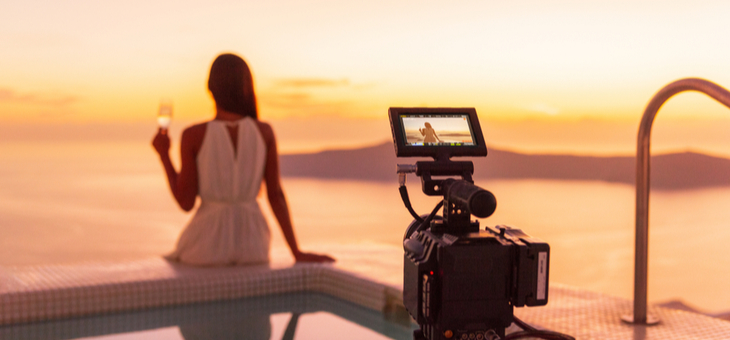Bad: Over tourism
It’s no secret that the streets are getting more crowded and the lines at attractions are extending. But people are travelling more than ever. In 2010, there were 950.80 million international tourist arrivals globally. This skyrocketed to 1.40 billion in 2018 and is expected to continue to rise. It puts strain on local communities and resources, has bad environmental outcomes and drives up local rent prices and living costs. But, hey, we all want our chance to see the world.
Good: Slow travel
The days of rushing from attraction to attraction, gathering photographic evidence that you were, in fact, having fun on your holiday are over … or at least fading away. It seems that the past decade has brought on the slow travel trend, and we’re all grateful for it. Take each day as it comes, absorb your surroundings and don’t miss an opportunity as you travel and relax at your own pace.
Bad: Doing it for the Gram
In 2018, 74 per cent of travellers used social media. Sixty per cent of all travellers and a whopping 97 per cent of all millennials share photos on social media while they travel. In 2019, one million travel related hashtags were searched every week. A phrase you may have heard thrown around, ‘Do it for the gram’, encourages people to capture and post their experiences for the sole purpose of getting Instagram likes. This social media trend is likely to be behind the amateur photoshoots you witness at viewpoints or café tables, or behind groups of boys making risky or straight-up dumb decisions.
Good and bad: Airbnb
You can now easily book an affordable stay in a local’s home in 100,000 cities in more than 191 countries worldwide. You get the chance to explore local neighbourhoods, live like a local and all for a reasonable price. While this may sound good, Airbnb has a dark side. There is a seemingly endless stream of complaints online about misleading descriptions, poor living conditions and bad hosts. And if something goes wrong, you’re on your own. It also drives up the costs for locals, making them involuntary subjects to the travel industry.
Good: Sustainable travel
According to Booking.com, 72 per cent of travellers believe that people need to make sustainable travel choices in order to save the planet. With tourism responsible for nearly eight per cent of the world’s carbon emissions, it’s no wonder ethical travellers are choosing more sustainable options. The growing trend among airlines – responsible for most of the industry’s pollution – to offset carbon emissions is a prime example. Other groups are also jumping on the trend. Intrepid Travel now offsets its trips by investing in renewable energy and activity providers Undiscovered Mountains have planted their own forest in Portugal.
Bad: Influencers
Have you ever been to Santorini and seen wistful blondes staring off into the distance and thought, ‘What an odd place to bring a ballgown?’ You, my friend, have spotted an influencer. They’re an ever-growing breed, and can be spotted around most major tourist attractions, distinguishable from the common tourist by the heavy make-up, designer clothing and the presence of a partner – oops, I mean professional photographer – following them around. Sometimes sporting thousands or millions of followers on social media, these influencers hog the best viewpoints and sell a glorified version of travel to their followers. And let’s face it, no-one likes to see someone wearing silk and looking like a model when we’re panting around with suitcases.
Good: Social solo travellers
Solo travellers now make up 11 per cent of the travel market, 84 per cent of whom are women. There has been a 131 per cent increase in the number of Google searches for ‘solo travel’ since 2016. One in six people have already holidayed alone and 25 per cent would consider taking a solo trip in the next year. According to Condor, 40 per cent of 55 to 64-year-olds have travelled alone in the past year. And the travel industry is cottoning on. There are an increasing number of trips, activities and cruises especially designed for solo travellers. Many of these provide platforms for solo travellers to meet up and exchange stories, making for more social solo trips.
Good and bad: The Brooklyn Effect
Have you noticed the growing number of factory-to-loft conversions, surrounded by artsy stores and boojee cafes? These little alternative hubs seem to be popping up in second cities all around the world. Fodors.com calls it the ‘Brooklyn Effect’. When Manhattan’s rent became too high and competitive, people escaped to Brooklyn, where things were more affordable and soon became trendier. Many other cities, often less popular or well-known compared to their capital counterparts, are using this model to gentrify and reboot themselves for tourists. On the plus side, who doesn’t love art galleries, experimental cuisine, music and boutiques? On the down side, it drives rent prices up for the locals, forcing some of them to leave their own neighbourhoods, and can change or ignore the pre-existing culture.
If you enjoy our content, don’t keep it to yourself. Share our free eNews with your friends and encourage them to sign up.
Related articles:
What is slow travel?
Disturbing Aussie travel trend
Boomers the bravest travellers

